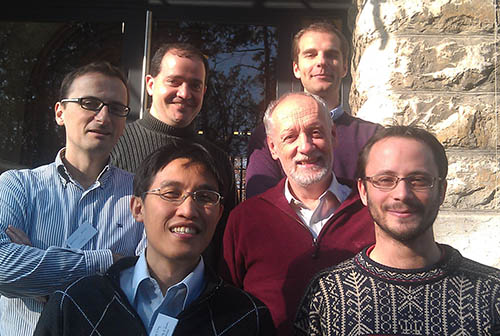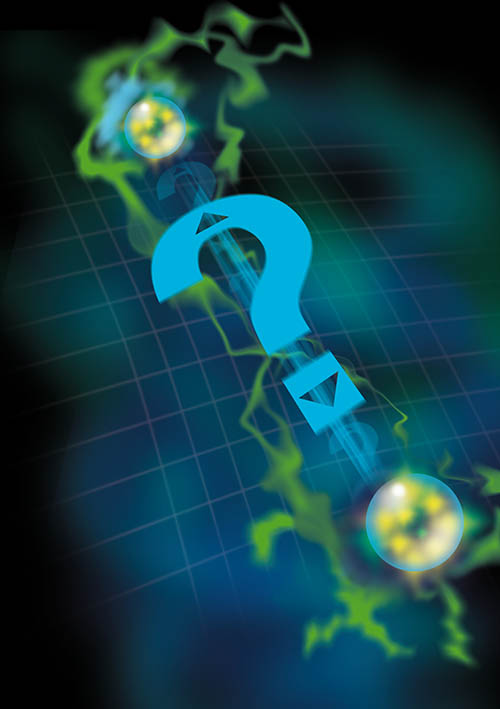Highlights
Looking beyond space and time to cope with quantum theory

International collaborators (from left-to right): front row, Yeong-Cherng Liang and Jean-Daniel Bancal; middle row, Antonio Acín and Nicolas Gisin; back row, Valerio Scarani and Stefano Pironio.

Trying to explain quantum "spooky action at a distance" using any kind of signal pits Einstein's relativity against our concept of a smooth spacetime. Credit: Timothy Yeo / CQT, National University of Singapore
The possibility that strange quantum behaviour can be explained by 'hidden influences' is testable in a new way, thanks to work by researchers at the Centre for Quantum Technologies and their collaborators in Switzerland, Beligum and Spain. The proposed experiment could force us to make a choice between extremes to describe the behaviour of the Universe.
In a paper published online 28 October in Nature Physics, the team present the 'hidden influence inequality' that enables their proposal. The inequality exposes how quantum predictions challenge our best understanding about the nature of space and time, Einstein's theory of relativity. Nature Physics notes the work with a Perspective by an independent expert, which also puts the result in broader context.
"We are interested in whether we can explain the funky phenomena we observe without sacrificing our sense of things happening smoothly in space and time," says CQT Research Fellow Jean-Daniel Bancal, first author on the paper. He carried out the research as a PhD student at the University of Geneva in Switzerland before joining in October the CQT group of Valerio Scarani, also an author on the paper. Valerio is a CQT Principal Investigator and Professor at the National University of Singapore.
It was Einstein who first drew attention to the worrying implications of what he termed the "spooky action at a distance" predicted by quantum mechanics. Quantum theory predicts bizarre behaviour for particles — such as two 'entangled' particles behaving as one even when far apart — that seems to violate our sense of cause and effect in space and time. Physicists call such behaviour 'nonlocal'. Common sense tells us that any such coordinated behaviour must result from one of two arrangements. First, it could be arranged in advance. The second option is that it could be synchronised by some signal sent between the particles.
In the 1960s, John Bell came up with the first test to see whether entangled particles followed common sense. Specifically, a test of a 'Bell inequality' checks whether two particles' behaviour could have been based on prior arrangements. If measurements violate the inequality, pairs of particles are doing what quantum theory says: acting without any 'local hidden variables' directing their fate. Starting in the 1980s, experiments have found violations of Bell inequalities time and time again.
Quantum theory was the winner, it seemed. However, conventional tests of Bell inequalities can never completely kill hope of a common sense story involving signals that don't flout the principles of relativity. That's why the researchers set out to devise a new inequality that would probe the role of signals directly.
Last year, former CQTian Esther Hänggi and her collaborators had tried taking a different approach to the same problem. Their exploration of what they called the 'transitivity' of non-locality, described in a paper in Physical Review Letters, showed that testing hidden influences was possible in some non-local scenarios, but fell short of finding a test that could be applied in the specific quantum case.
Experiments have already shown that if you want to invoke signals to explain things, the signals would have to be travelling faster than light — more than 10,000 times the speed of light, in fact. To those who know that Einstein's relativity sets the speed of light as a universal speed limit, the idea of signals travelling 10,000 times as fast as light already sets alarm bells ringing. However, physicists have a getout: such signals might stay as 'hidden influences' — useable for nothing, and thus not violating relativity. Only if the signals can be harnessed for faster-than-light communication do they openly contradict relativity.
The new hidden influence inequality shows that the getout won't work when it comes to quantum predictions. To derive their inequality, which sets up a measurement of entanglement between four particles, the researchers considered what behaviours are possible for four particles that are connected by influences that stay hidden and that travel at some arbitrary finite speed.
Mathematically (and mind-bogglingly), these constraints define an 80-dimensional object. The testable hidden influence inequality is the boundary of the shadow this 80-dimensional shape casts in 44 dimensions. The researchers showed that quantum predictions can lie outside this boundary, which means they are going against one of the assumptions. Outside the boundary, either the influences can't stay hidden, or they must have infinite speed.
Experimental groups can already entangle four particles, so a test is feasible in the near future (though the precision of experiments will need to improve to make the difference measurable). Such a test will boil down to measuring a single number. In a Universe following the standard relativistic laws we are used to, 7 is the limit. If nature behaves as quantum physics predicts, the result can go up to 7.3.
So if the result is greater than 7 — in other words, if the quantum nature of the world is confirmed — what will it mean?
Here, there are two choices. On the one hand, there is the option to defy relativity and 'unhide' the influences, which means accepting faster-than-light communication. Relativity is a successful theory that researchers would not call into question lightly, so for many physicists this is seen as the most extreme possibility.
The remaining option is to accept that influences must be infinitely fast — or that there exists some process that has an equivalent effect when viewed in our spacetime. The current test couldn't distinguish. Either way, it would mean that the Universe is fundamentally nonlocal, in the sense that every bit of the Universe can be connected to any other bit anywhere, instantly. That such connections are possible defies our everyday intuition and represents another extreme solution, but arguably preferable to faster-than-light communication.
"Our result gives weight to the idea that quantum correlations somehow arise from outside spacetime, in the sense that no story in space and time can describe them," says Nicolas Gisin, Professor at the University of Geneva, Switzerland, and member of the team.
Other members of the team, in addition to those mentioned above, are Stefano Pironio from the Free University of Bruxelles in Belgium, Antonio Acín from the Institute of Photonic Sciences (ICFO) in Barcelona, Spain, and Yeong-Cherng Liang from the University of Geneva.
For more details, see "Quantum nonlocality based on finite-speed causal influences leads to superluminal signalling", Nature Physics, DOI:10.1038/NPHYS2460 (2012) and the Perspective by Terry Rudolph of Imperial College London "Quantum causality: information insights", Nature Physics DOI:10.1038/nphys2470 2012).
Selected media coverage:
- PhysOrg: Researchers look beyond space and time to cope with quantum theory
- Science 2.0: Hidden Influence Inequality — Bell's Inequality With Less Drama
- Science Daily: Looking Beyond Space and Time to Cope With Quantum Theory
The paper's authors have written a semi-popular account of the work for the educational website 2physics.com. See Quantum Statistics from Outside Space and Time






